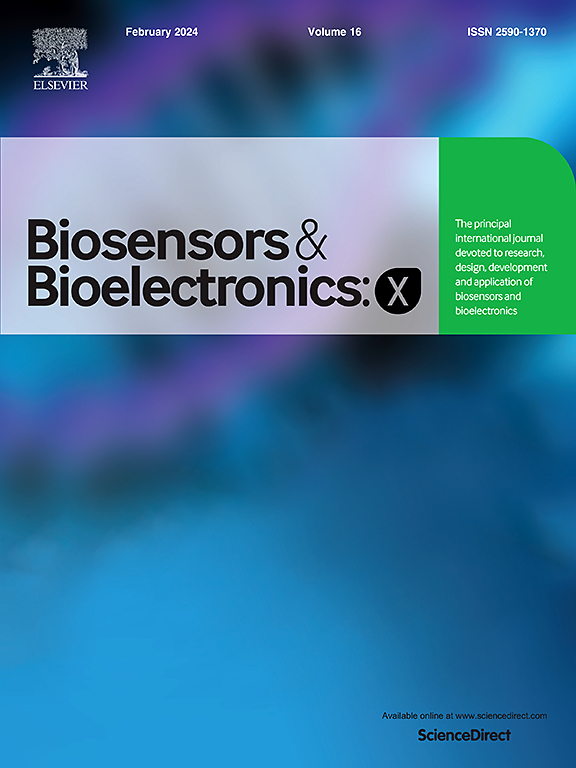Practical considerations for DNA sensing using Faradaic electrochemical impedance spectroscopy on ENIG PCB electrodes
IF 10.61
Q3 Biochemistry, Genetics and Molecular Biology
引用次数: 0
Abstract
Electroless nickel immersion gold (ENIG) finish printed circuit board (PCB) substrates offer a cost-effective solution for electrochemical sensing of biomolecules. Electrochemical impedance spectroscopy (EIS) is highly sensitive and can differentiate between bioelectrochemical circuit elements over a wide frequency range. Traditional Faradaic EIS measurements often focus on charge transfer resistance to determine analyte concentration. However, the long measurement time required to perform such EIS measurements down to very low frequencies (typically 0.1 Hz) can adversely affect the ENIG PCB due to gold layer degradation and copper corrosion. To overcome these issues, we propose using the constant phase element (CPE) in the electrical equivalent circuit in EIS measurements for DNA sensing. Our approach employs ENIG PCB electrodes functionalized with thiolated single-stranded DNA probes targeting the uidA gene of E. coli. We evaluate the specificity of this sensing scheme to a 166 bp complementary amplicon from E. coli against non-complementary amplicons of different lengths from E. coli and bacteriophage Phi6. By operating at higher frequencies (10 Hz), CPE analysis reduces measurement times and minimizes the risk of PCB degradation. Preliminary findings indicate that the CPE impedance exhibits concentration-dependent changes with increasing target DNA concentrations. We also present preliminary results for utilizing this sensing mechanism to detect E. coli from wastewater samples.
在ENIG PCB电极上使用法拉第电化学阻抗谱进行DNA传感的实际考虑
化学镀镍浸金(ENIG)表面处理印刷电路板(PCB)衬底为生物分子的电化学传感提供了一种经济有效的解决方案。电化学阻抗谱(EIS)具有很高的灵敏度,可以在很宽的频率范围内区分生物电化学电路元件。传统的法拉第EIS测量方法通常关注电荷转移电阻(Rct)来确定分析物的浓度。然而,由于金层降解和铜腐蚀,执行这种EIS测量所需的长测量时间低至非常低的频率(通常为0.1 Hz)可能会对ENIG PCB产生不利影响。为了克服这些问题,我们建议在EIS测量DNA传感的等效电路中使用恒相元件(CPE)。我们的方法采用ENIG PCB电极功能化的硫代单链DNA探针靶向大肠杆菌的uidA基因。我们评估了该传感方案对来自大肠杆菌的166 bp互补扩增子与来自大肠杆菌和噬菌体Phi6的不同长度的非互补扩增子的特异性。通过在更高的频率(>10 Hz)下工作,CPE分析减少了测量时间,并最大限度地降低了PCB退化的风险。初步结果表明,CPE阻抗随靶DNA浓度的增加呈现浓度依赖性变化。我们还介绍了利用这种传感机制检测废水样品中的大肠杆菌的初步结果。
本文章由计算机程序翻译,如有差异,请以英文原文为准。
求助全文
约1分钟内获得全文
求助全文
来源期刊

Biosensors and Bioelectronics: X
Biochemistry, Genetics and Molecular Biology-Biophysics
CiteScore
4.60
自引率
0.00%
发文量
166
审稿时长
54 days
期刊介绍:
Biosensors and Bioelectronics: X, an open-access companion journal of Biosensors and Bioelectronics, boasts a 2020 Impact Factor of 10.61 (Journal Citation Reports, Clarivate Analytics 2021). Offering authors the opportunity to share their innovative work freely and globally, Biosensors and Bioelectronics: X aims to be a timely and permanent source of information. The journal publishes original research papers, review articles, communications, editorial highlights, perspectives, opinions, and commentaries at the intersection of technological advancements and high-impact applications. Manuscripts submitted to Biosensors and Bioelectronics: X are assessed based on originality and innovation in technology development or applications, aligning with the journal's goal to cater to a broad audience interested in this dynamic field.
 求助内容:
求助内容: 应助结果提醒方式:
应助结果提醒方式:


